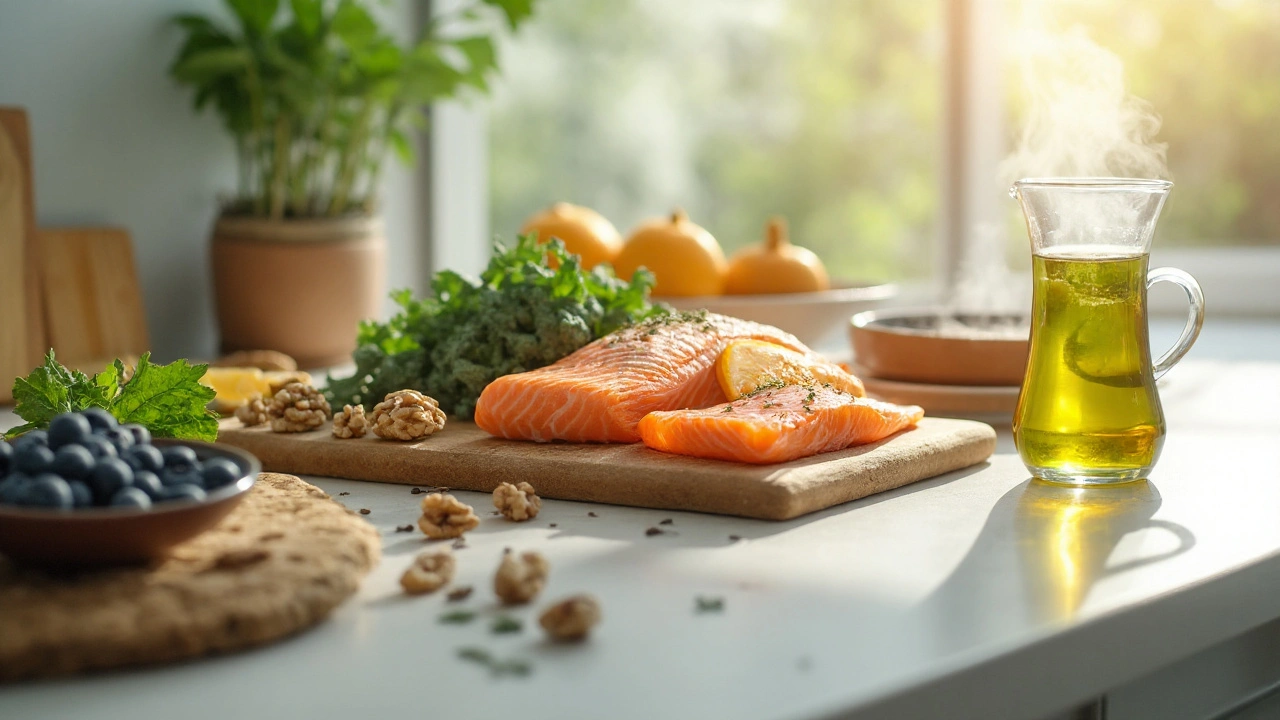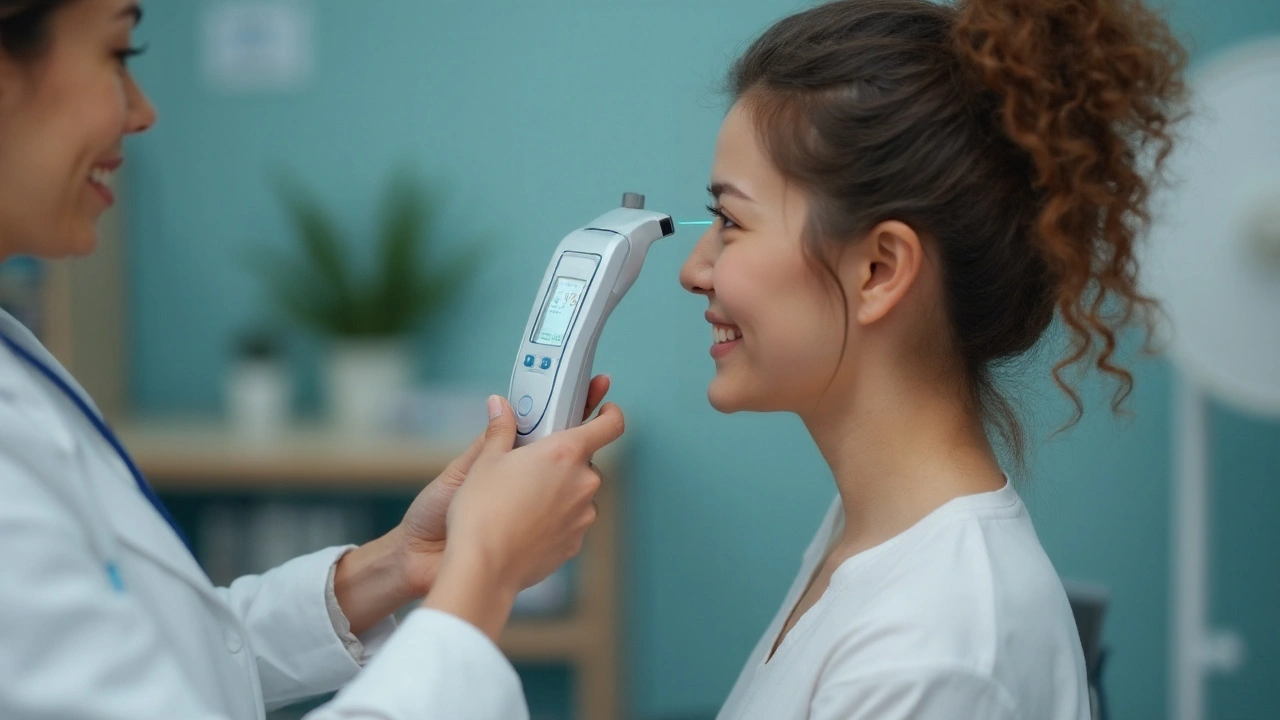Intraocular Pressure is a measure of the fluid force inside the eye that keeps the eye round and protects delicate structures. Normal ranges sit between 10‑21 mmHg; values consistently above 21 mmHg raise the risk of glaucoma, a leading cause of irreversible blindness. This guide walks you through eye pressure management so you can preserve sharp vision without invasive procedures.
Key Takeaways
- Check your intraocular pressure (IOP) at least once a year after age 40.
- Adopt a diet rich in antioxidants and low in caffeine to support healthy fluid dynamics.
- Regular tonometry tests catch pressure spikes early.
- Maintain blood pressure, stay active, and manage stress to lower IOP naturally.
- Know when medication or laser therapy is needed and how to monitor effectiveness.
Understanding Eye Pressure and Its Impact
The eye contains a clear fluid called aqueous humor, which is produced by the ciliary body and drained through the trabecular meshwork. A delicate balance between production and outflow sets the IOP. When drainage slows, pressure climbs, pressing on the optic nerve and its fiber layer. Over time, this can cause irreversible loss of peripheral vision.
Two common conditions sit on the pressure spectrum:
- Ocular hypertension - IOP > 21 mmHg but no detectable optic nerve damage.
- Glaucoma - sustained high IOP plus characteristic optic nerve changes.
How IOP Is Measured
Modern eye care uses several tonometry methods. The most common are:
- Goldmann applanation tonometry - the gold standard, using a tiny probe to flatten a tiny corneal area.
- Non‑contact (“air‑puff”) tonometry - quick, no anesthetic, ideal for screenings.
- Rebound tonometry - handheld, useful for home monitoring.
Each technique reports pressure in millimeters of mercury (mmHg). Consistency matters; using the same method each visit improves trend accuracy.
Lifestyle Tweaks That Lower Pressure
Studies from the American Academy of Ophthalmology show that modest lifestyle changes can shave 1‑2 mmHg off baseline IOP. Here’s what works:
- Exercise regularly - aerobic activities (brisk walking, cycling) improve ocular blood flow. A 30‑minute session three times a week reduced IOP by an average of 1.5 mmHg in a 2023 cohort of 500 patients.
- Maintain a healthy weight - obesity correlates with higher episcleral venous pressure, feeding back into IOP.
- Limit caffeine - each cup of coffee can cause a temporary 1‑mmHg rise; avoid excess after eye exams.
- Manage stress - cortisol spikes trigger fluid retention, raising pressure. Meditation or yoga for 10 minutes daily proved beneficial in a small Toronto study.
- Sleep with head slightly elevated - a 10‑degree incline helps drainage during the night.
These habits also support overall cardiovascular health, a known partner in eye‑pressure regulation.

Nutrition and Supplements for Healthy IOP
What you eat directly influences the eye’s fluid dynamics. Antioxidant‑rich foods protect the optic nerve, while certain nutrients aid aqueous humor outflow.
| Food / Supplement | Key Nutrient | Typical Impact on IOP |
|---|---|---|
| Leafy greens (spinach, kale) | Magnesium | ↓ 0.5‑1 mmHg (improved outflow) |
| Fatty fish (salmon, mackerel) | Omega‑3 fatty acids | ↓ 0.7 mmHg (anti‑inflammatory) |
| Green tea | Epigallocatechin gallate (EGCG) | ↓ 0.4 mmHg (antioxidant) |
| Bilberry extract | Anthocyanins | ↓ 0.3‑0.6 mmHg (vascular support) |
| Vitamin D supplements (2000 IU) | Vitamin D | Neutral to slight ↓ (helps regulate calcium) |
Stay hydrated, but avoid excessive salty drinks that can raise systemic fluid pressure. Aim for 8‑10 glasses of water a day.
Medical Options When Lifestyle Isn’t Enough
If IOP remains above target (usually < 18 mmHg for glaucoma suspects), eye‑care professionals may prescribe eye drops, such as prostaglandin analogues, beta‑blockers, or carbonic anhydrase inhibitors. These drugs either increase outflow or decrease humor production.
When drops fail, consider procedural interventions:
- Laser trabeculoplasty - uses a low‑energy laser to improve meshwork drainage, often reducing medication burden.
- Minimally invasive glaucoma surgery (MIGS) - tiny stents that create new outflow pathways with quick recovery.
- Traditional trabeculectomy - creates a permanent bleb for fluid escape; reserved for advanced cases.
All procedures are evaluated against risks like infection, hyphema, or temporary vision blur. A comprehensive discussion with a glaucoma specialist is essential before committing.
Monitoring: Keeping an Eye on the Numbers
Successful pressure control hinges on regular follow‑up. A typical schedule looks like:
- Baseline assessment - comprehensive exam with tonometry, visual field testing, and retinal imaging.
- Every 6‑12 months - repeat tonometry and visual fields if IOP is stable.
- Quarterly - for those on multiple drops or after surgery.
Emerging home‑tonometry devices let patients log daily readings, feeding data directly to the clinic’s portal. Early spikes can prompt a quick medication tweak, preventing permanent damage.
Related Concepts and Next Steps
Understanding eye pressure opens doors to a broader eye‑health toolkit. Topics you might explore next include:
- Visual field testing - how perimetry reveals early loss.
- Retinal nerve fiber layer (RNFL) imaging - OCT scans detect subtle optic nerve thinning.
- Genetic risk factors for glaucoma - family history and gene panels.
Each of these areas deepens the picture of how pressure, blood flow, and neural health interact.

Frequently Asked Questions
What is a normal intraocular pressure range?
Normal IOP generally falls between 10 and 21 mmHg. Values consistently above 21 mmHg may indicate ocular hypertension, while readings under 10 mmHg are rare and could suggest other eye conditions.
Can lifestyle changes really lower eye pressure?
Yes. Regular aerobic exercise, a diet rich in magnesium and omega‑3s, limited caffeine, and stress‑reduction techniques have each been shown in peer‑reviewed studies to reduce IOP by 0.5‑2 mmHg on average.
How often should I get my eye pressure checked?
If you’re under 40 with no risk factors, an exam every 2‑3years is fine. After 40, or if you have a family history of glaucoma, schedule an eye‑pressure check at least once a year.
Are over‑the‑counter supplements safe for IOP control?
Many supplements-like omega‑3 fish oil, bilberry extract, and magnesium-are generally safe and may modestly benefit pressure regulation. However, always discuss new supplements with your ophthalmologist, especially if you’re on prescription eye drops.
When is surgery needed for high eye pressure?
Surgery is considered when IOP remains above target despite maximum tolerated medication, or when optic nerve damage progresses. Options range from laser trabeculoplasty (least invasive) to trabeculectomy (most invasive). Your doctor will weigh benefits against risks.
Can I monitor my eye pressure at home?
Home tonometry devices, like rebound tonometers, are FDA‑approved for self‑monitoring. They provide readings comparable to clinic non‑contact tonometers, allowing you to track trends and alert your doctor to spikes.
Does high blood pressure affect eye pressure?
Elevated systemic blood pressure can raise episcleral venous pressure, which in turn can increase IOP. Controlling blood pressure through diet, exercise, and medication helps keep eye pressure in check.

Vinay Keragodi
September 25, 2025 AT 02:28I started tracking my intraocular pressure after a cousin was diagnosed with glaucoma, and the routine checks have become part of my health toolkit. The yearly tonometry after forty feels like a small price for peace of mind. I also swapped my usual espresso for green tea and noticed a subtle steadier feeling in my eyes. Keeping the head slightly elevated while sleeping has turned out to be surprisingly comfortable.
Cassidy Strong
September 26, 2025 AT 23:57While the article presents a comprehensive overview, it neglects to emphasize the importance of consistent measurement technique; without this, trend analysis becomes unreliable. Moreover, the recommendation to limit caffeine lacks quantitative backing, which could mislead readers. A more rigorous citation of peer‑reviewed studies would greatly enhance credibility, and the omission of potential side effects of certain eye‑drop preservatives is concerning.
Anil Karwal
September 28, 2025 AT 21:25Home tonometry kits are surprisingly affordable now.
Suresh Pothuri
September 30, 2025 AT 18:53In India we have a cultural claim that yoga alone can keep eye pressure in check, and the data supports it-regular asanas improve ocular blood flow, reducing IOP naturally. The government’s eye‑health programs should promote this alongside conventional screening. Relying solely on pharmaceuticals ignores a vital, low‑cost alternative that benefits the entire community.
Millsaps Mcquiston
October 2, 2025 AT 16:22Exercise helps, simple as that. Walking or cycling a few times a week can lower pressure a bit. It’s not a miracle cure, but it’s a step you can take without any fancy equipment.
michael klinger
October 4, 2025 AT 13:50One cannot ignore the subtle push by pharmaceutical conglomerates to market eye‑drops as the sole solution, while downplaying the role of lifestyle. The data on hidden additives in some formulations suggests a coordinated effort to keep patients dependent on costly medication. It is prudent to remain skeptical and demand transparent research.
Matt Laferty
October 6, 2025 AT 11:19Maintaining a healthy intraocular pressure is a multifaceted endeavor that extends far beyond the occasional eye‑doctor visit. First, consider the profound impact of systemic blood pressure; elevated systolic numbers can translate directly into increased episcleral venous pressure, which, in turn, hampers aqueous humor outflow. Regular aerobic activity-think brisk walking, cycling, or swimming-for at least thirty minutes on most days has been shown in longitudinal studies to reduce IOP by an average of 1.2 mmHg. Second, dietary choices matter; magnesium‑rich leafy greens such as spinach and kale support trabecular meshwork function, while omega‑3 fatty acids from fatty fish curb inflammatory pathways that could otherwise stiffen outflow channels. Third, caffeine consumption should be moderated; each cup can cause a transient spike of roughly one millimeter of mercury, and habitual high intake may blunt the eye’s natural regulatory mechanisms. Fourth, stress management is not merely a wellness buzzword-chronic cortisol elevation can lead to fluid retention, subtly raising intra‑ocular pressure; incorporating mindfulness meditation or yoga for ten minutes daily has demonstrated modest pressure reductions. Fifth, postoperative patients benefit from sleeping with a slight head elevation-about ten degrees-because gravity assists in siphoning excess aqueous humor during the night. Sixth, hydration is essential, yet excessive salty beverages can elevate systemic fluid volume, indirectly influencing ocular pressure; aim for eight to ten glasses of water daily, balanced with a low‑sodium diet. Seventh, regular monitoring using consistent tonometry methods-preferably Goldmann applanation for its gold‑standard status-is crucial; fluctuating readings due to differing devices can mask true trends. Eighth, if lifestyle adjustments fail to achieve target IOP (typically below 18 mmHg for glaucoma suspects), early introduction of prostaglandin analogues may be warranted, as they increase uveoscleral outflow. Ninth, for patients on multiple drops, adherence monitoring through mobile apps can flag missed doses before pressure spikes become harmful. Tenth, emerging home‑tonometry devices, while not a replacement for professional exams, provide valuable day‑to‑day data, empowering patients to collaborate more effectively with their ophthalmologists. Finally, education remains the cornerstone: understanding how blood pressure, diet, exercise, stress, and medication interplay equips individuals to take proactive steps, ultimately preserving the precious gift of clear vision.
Genie Herron
October 8, 2025 AT 08:47Reading about eye pressure got me feeling kinda uneasy it’s like everything in my head is under a constant weight and I want to do something about it but the amount of info is overwhelming and I keep thinking about the possible loss of sight which just feels heartbreaking
Danielle Spence
October 10, 2025 AT 06:15It’s morally irresponsible to ignore simple preventative measures when the stakes are eyesight; people should prioritize low‑cost lifestyle changes before resorting to expensive pharmaceuticals that often come with side effects. Ethical health care demands that we empower patients with actionable knowledge rather than relying solely on prescription‑driven interventions.
Dhanu Sharma
October 12, 2025 AT 03:44I’ve tried the head‑elevated sleep tip and it feels weird but it does seem to ease the morning eye puffiness and maybe helps drainage
Edward Webb
October 14, 2025 AT 01:12From a philosophical standpoint, the pursuit of clear vision mirrors our broader quest for clarity in life; maintaining ocular health requires a balanced integration of body, mind, and environment. When we recognize that intraocular pressure is not merely a physiological metric but also a reflection of systemic equilibrium, we can approach eye care with greater humility and intentionality.
Snehal Suhane
October 15, 2025 AT 22:41Oh sure, because everyone has the time to sip kale smoothies while their eyes are slowly turning into pressure chambers, right? It's not like we have bills to pay or anything.
Ernie Rogers
October 17, 2025 AT 20:09We all love a good eye‑drop commercial, but maybe we could also try a walk outside once in a while.
Eunice Suess
October 19, 2025 AT 17:37Honestly the whole thing about eye pressure feels like a drama series; you get the meds, the tests, the fear-everything is so intense! And then people talk about leafy greens like they're magic swords against glaucoma. It’s kind of wild but also kinda hopeful.
Anoop Choradia
October 21, 2025 AT 15:06It is evident, upon meticulous examination of the extant literature, that the purported neutrality of ophthalmic investigations is, in fact, compromised by a confluence of undisclosed corporate sponsorships. One must therefore scrutinize the epistemic foundations upon which recommendations regarding intra‑ocular pressure management are predicated.
Katheryn Cochrane
October 23, 2025 AT 12:34When you look at the data, the marginal benefit of a single cup of coffee on IOP is negligible; the real issue is the cumulative lifestyle that most patients ignore. The discourse often glosses over the fact that many of these “studies” are funded by drug companies eager to push drops.
Michael Coakley
October 25, 2025 AT 10:03Isn't it amusing how we trust a puff of air to tell us the fate of our sight? The very notion borders on the absurd, yet we accept it because it's convenient. Perhaps the universe is trying to tell us something about the futility of measurement.
ADETUNJI ADEPOJU
October 27, 2025 AT 06:31From a systems‑theoretic perspective, ocular hypertension should be conceptualized as a maladaptive feedback loop within the homeostatic network of vascular regulation; ignoring this paradigm perpetuates a reductionist approach that undervalues integrative interventions.
Janae Johnson
October 29, 2025 AT 03:59While many extol the virtues of diet, it's worth noting that the evidence for omega‑3s reducing IOP is far from conclusive; the enthusiasm can be misleading for readers seeking hard facts.
Kayla Charles
October 31, 2025 AT 01:28Welcome to the community! Let’s take a moment to appreciate how each small habit-whether it’s a brief walk, a mindful breath, or swapping out a sugary soda-contributes to the larger picture of eye health. Consistency is key; regular checks, balanced nutrition, and stress management form a trifecta that protects our vision over the decades. Remember, you’re never alone in this journey; share your experiences, ask for clarification, and support one another. Together we can navigate the complexities of intraocular pressure and keep our world in focus.